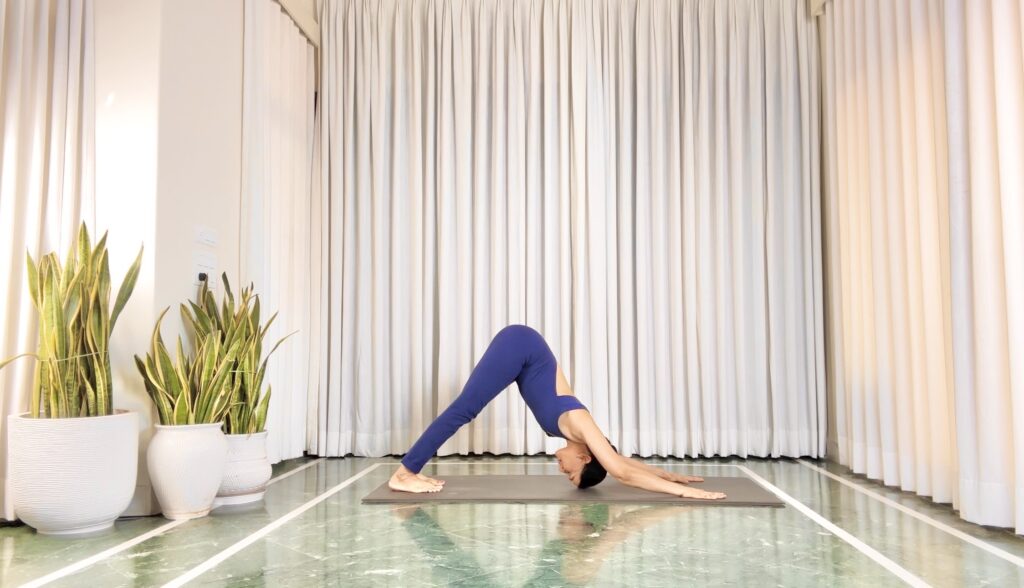Within the realm of yoga practice and yoga postures, Surya Namaskar is one of the simplest yet most effective modules; also the most popular. In fact when most people talk of yoga, they instantly connect it to the Sun Salutation Exercise.
The Sun Salutation works every major muscle group of the body. In addition it utilises deep breathing in a very effective manner, training the practitioner to coordinate movement and breath smoothly, which engages the respiratory system and cleanses the lungs thoroughly.
While most people are impressed with the physical Benefits of the Surya Namaskar Exercise, I’ve noticed first-hand the transformational effect that the regulated breathing has. The deep inhales and exhales coordinated with the backbends and the forward bends, trains one to breathe correctly, breathe deeply and we learn to replace our habitual short breathing with long graceful breaths.
The Effect Of Mindful Breathing In Yoga
It is essentially our ‘Prana’ or ‘Life force’ working through our breath, which weaves through the three levels of our being, viz, our body, mind and soul and connects them all.
Prana keeps us alive and thriving. In yoga, we intentionally guide this pranic energy through pranayama. When we synchronise our breathing with our Sun Salutation movements, (or in fact with our everyday bodily movements) it makes the practice more dynamic, focussed, effective and effortless.
In Sun Salutation, we are alternating between forward and backward bends. Every backbend is accompanied with an inhale and every forward with an exhaling breath. Breathing mindfully and correctly during the flow allows us to go deeper into the posture. If we are breathing incorrectly then our movement and our breath are at odds.
Breathing Through Each Posure In Surya Namaskar
Let’s go through how we should match our breath with each of the twelve postures in Surya Namaskar Step by Step.
Pranamasana (Prayer Pose)
Here, we exhale slowly as we stand tall with our feet together. We bring our palms together as we simultaneously exhale slow and long, letting all the stale air exit from our lungs.
Hatsa Uttanasana (Raised Arms Pose)
We inhale as we stretch our arms forward up and back, arching into a backbend, expanding our chest and drawing oxygen deeply into our lungs with the inhale.
Uttanasana/Padahastasana/ Hastapadasana (Standing Forward Bend)
This deep forward fold facilitates expelling the stale air out from the depths of our lungs. We allow our body to relax as we let the breath out.
Ashwa Sanchalanasana (Equestrian Pose)
Inhaling we and step one leg back. As we breathe in with this gentle backbend, we lengthen our spine, keep the chest lifted and ground our back foot and shin into the floor.
Dandasana (Plank Pose) or Adho mukh svanasana (Downward Dog Pose)
Exhaling fully we step the other leg back into Plank or we step the other leg back into the inverted ‘V’ position. Some schools of yoga do the plank and some do the ‘Downward Facing Dog’ both are fine. Down Dog is a forward bend; we always exhale into forward bends. This posture again helps empty the lungs.
Ashtanga Namaskara (Salute With Eight Limbs)
After exhaling in the previous pose, we hold our breath outside as we lower our knees, chest and chin (in this order) to the floor.
Bhujangasana (Cobra Pose)
Inhaling deeply, we move our spine forward, up and back, arching back as much as our flexibility allows but the hips and pubic bone remain in contact with the floor. This lifted chest position allows the lungs to fill up completely with life giving oxygen.
Adho Mukha Svanasana (Downward-Facing Dog)
Exhaling, we push down with our hands and move our hips back and up, bringing our body into the inverted V position. The exhaling breath not only drains and cleanses the lungs, it also generates deep muscular release.
Ashwa Sanchalanasana (Equestrian Pose)
Inhaling we step the same foot forward (which we had taken back) between the hands, lifting the chest and filling our lungs with enriching oxygen and ‘prana’.
Uttanasana/Padahastasana/ Hastapadasana (Standing Forward Bend)
With a long deep exhale, we hinge from the hips, bending forward again keeping the upper body as limp and relaxed as we can. This forward bending position facilitates draining the lungs of all noxious gases.
Hasta Uttanasana (Raised Arms Pose)
After draining the lungs, we now start straightening up and we arch back with a deep inhale, circling our arms forward, and overhead alongside the head. The bending back stretches the ribcage, expands the chest and helps fill the lungs optimally.
Pranamasana (Prayer Pose)
Finally, with an exhale we return to our upright starting position, hands at the heart.
Why Mindful Breathing Changes Everything?
Mindful breathing during Surya Namaskar keeps us from getting distracted and helps our mind stay very focussed on the posture being executed. It also activates our body’s relaxation response, producing better results. The deep long breaths accompanying the postures allow us to stretch fully while maintaining a level of relaxation and simultaneously building up our energy reserves.
All in all, mindful breathing changes the performance of the Sun Salutation, enhancing it’s benefits. You are welcome to join my Online Yoga Classes at ‘Yoga With Sapna’ to gain a more thorough understanding of the process and get the best out of each posture.

